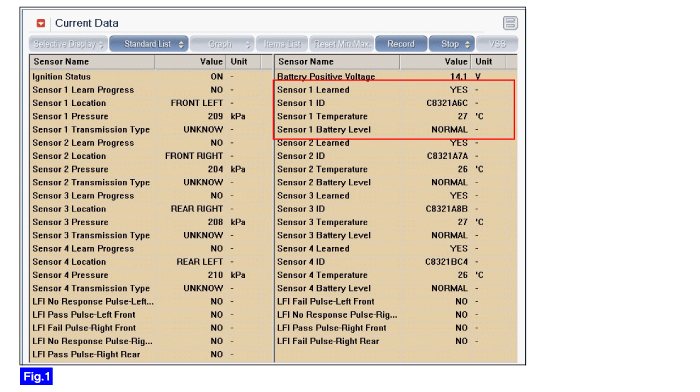Monitor the parameters related to 'Front Left WE sensor(Sensor 1)'.
Specification : the parameters related to 'Front Left WE sensor' are displayed normally.

Fig.1) Sensor current data (normal)

【Wheel Electronic (WE) sensor unit】- TPMS sensor
Each vehicle wheel is fitted with a Wheel Electronic (WE) sensor unit attached to the valve on the inside of the wheel. The WE unit is powered with a self-contained battery utilizing a high temperature rated CR (Manganese Dioxide Lithium) chemistry. The operating voltage range for the WE module is 1.8Vdc to 3.6Vdc, and the operating temperature range is -40℃ ~120℃. The WE measures tire pressure, temperature, and acceleration periodically. The pressure, temperature, and acceleration information is converted to digital form within the MCU inside the WE sensor.
The WE sensor is equipped with a Radio Frequency (RF) transmitter circuit which is used to periodically broadcast information from inside the tire. All WE sensor units operate on the same RF channel frequency, and each broadcast message includes pressure and temperature data, a unique ID code, operating state data, status information, and digital error-detection data.
The pressure measured by the WE sensor is an absolute pressure value. The pressure measurement range is 100kPa to 450kPa. The acceleration data is used within the WE sensor to determine whether the vehicle is moving or stationary. The acceleration status is the decision maker within the WE module that determines if the tire is moving or stationary. This measurement is used within the WE module to enable different operating modes depending on the status of the acceleration value. Over the fully specified operating temperature range, if the acceleration measurement is greater than or equal to 5G, the WE module assumes the tire is moving.
The basic function of the WE Sensor is to transmit frame every minute when WE is in mode MD(mode driving) mode. The WE sensor enters mode MP(Mode Parking) where it transmits RF messages once every 13 hours if acceleration is lower than 5g for 15 mimutes. When the WE sensor is in mode MFB(Mode First Burst : mode for Auto Location and Auto Learning), it transmits RF message once every 15 seconds.
This DTC indicates that the Front Left sensor has detected that it has an internal fault (measurement diagnosis or hardware diagnosis status). The most likely cause is sensor failure.
Item | Detecting Condition | Possible cause |
DTC strategy | ● Check RF message from FL sensor | ● Damage to FL WE sensor ● Faulty FL WE sensor |
Enable conditions | ● IGN ON | |
Threshold value | ● After reception of a single frame from WE sensor with pressure, temperature or acc set to 00h. (The pressure, temperature and acceleration value of a WE sensor data frame indicates 00h when the WE detected a fault of its sensors). ● Plausibility check detected a defect of temperature or pressure sensor or a defect of both sensors. (Pressure and temperature sensor are defect when they report irregular changes of pressure and temperature) | |
Mil On conditon | ● Active DTC is set |
Park the vehicle on a level surface.
Set up 'GDS' with 'GDS TPMS'.
Drive vehicle at a steady speed for more than 1minmute.
Select the "CURRENT DATA" function of "TPMS" system.
Select the "FULL" mode of "CURRENT DATA" function.
Monitor the parameters related to 'Front Left WE sensor(Sensor 1)'.
Specification : the parameters related to 'Front Left WE sensor' are displayed normally.

Fig.1) Sensor current data (normal)
Are the parameters normal?

▶ Fault is intermittent. It has been repaired and TPMS receiver module memory is not cleared yet.
▶ Go to "Verification of vehicle Repair" procedure.

▶ Replace Front Left WE sensor and register sensor ID with 'GDS TPMS'.
▶ Go to "Verification of Vehicle Repair" procedure.
After a repair, it is essential to verify that the fault has been corrected.
Connect TPMS exciter or scantool and select "Diagnostic Trouble Codes(DTCs)" mode
Using a TPMS exciter or scantool, Clear DTC.
Operate the vehicle within DTC Enable conditions in General information.
Are any DTCs present ?

▶ Go to the applicable troubleshooting procedure.

▶ System performing to specification at this time.